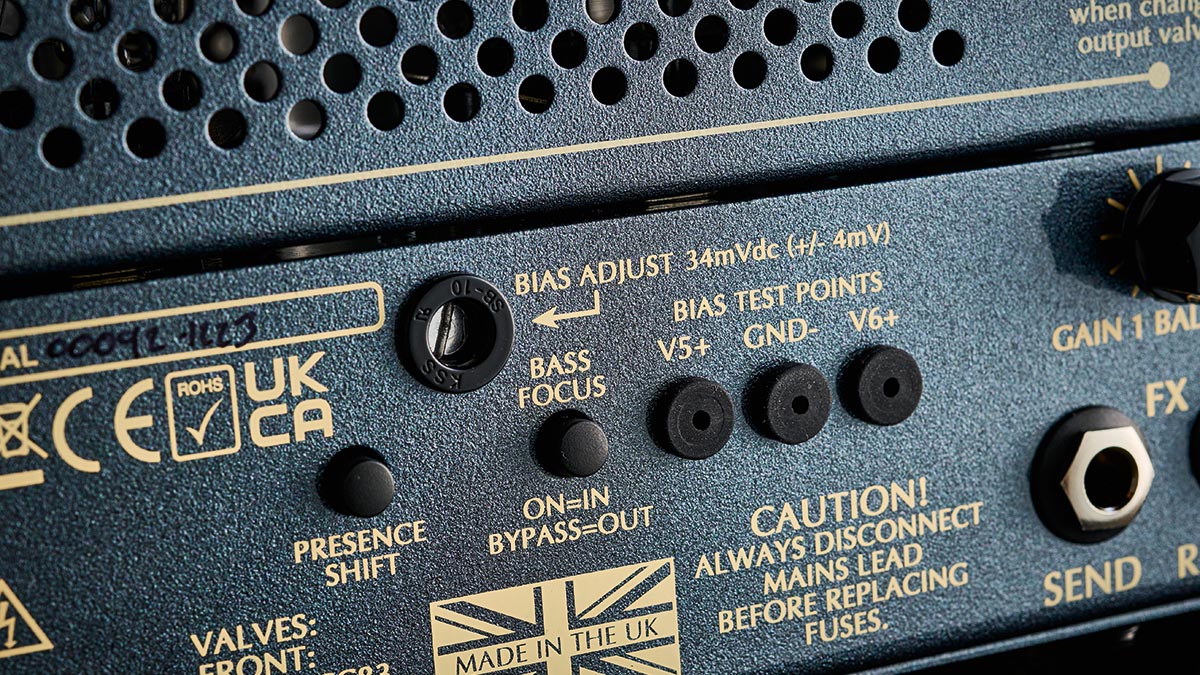Guitar World Verdict
Aimed at serious amateurs and professionals, it’s not the cheapest lunchbox metal head out there, but it’s made in the UK to a very high standard and, as with most things, you get what you pay for. If detuned modern rock and metal is your thing, it’s definitely one to check out.
Pros
- +
Top-quality high-gain head.
- +
Perfect for modern rock, metal and detuned instruments.
- +
New features improve flexibility.
- +
Rear-panel Bias Test Points and adjustment make it easier and safer to service
Cons
- -
Not so subtle for mild overdrive sounds.
- -
Dual-footswitch operation is a little confusing.
- -
Effects loop no longer footswitchable.
- -
Single-ended mode has been removed.
- -
No LEDs on front panel for channel mode/status.
You can trust Guitar World
One of the most popular British guitar influencers on YouTube, Rabea Massaad is well known as a tasteful and highly accomplished modern rock player who can out-metal the best of them whenever he needs to.
He’s also an artist and consultant for Victory Amplification and Victory’s VX Kraken is Massaad’s baby – the result of a longterm, ongoing collaboration that’s inspired a range of definitive British metal amps and pedals, which are a perfect fit for Massaad’s high-gain detuned signature tones.
Over the past few years, the lunchbox VX Kraken has been reworked and tweaked, and was recently released as VX The Kraken MKII Lunch Box Head. Let’s check out the new, improved version.
The MKII Lunch Box Head uses the same robust steel chassis and perforated steel lid as Victory’s other lunchbox amps, with a new graphite sparkle paint finish adding a touch of class. The steelwork is precision folded and uses larger than average machine screws to secure everything, so it’s easy to dismantle and service when needed.
This isn’t always the case with lunchbox products; to dodge mishaps we replace screws by hand to avoid stripping threads, fit them all loosely before tightening and use the correct screwdriver with the right sized tip.

Inside the chassis, the MKII’s electronics sit on one large high-quality printed circuit board, including most of the front- and rear-panel controls and all the valve bases. The resistors are metal film to minimise hiss, with clean bright solder joints and neatly bundled wiring.
Like its predecessor, the MKII Lunch Box Head is a two-channel head, with separate gain and master volume controls feeding a shared EQ. Gain I is a British-voiced crunch/rhythm channel, with a foot-switchable attenuated gain stage offering a new Clean mode, while Gain II is the American-voiced lead channel.
All the latest guitar news, interviews, lessons, reviews, deals and more, direct to your inbox!

These three voices can be accessed from the front-panel three-way toggle switch, or by using the supplied footswitches. The front panel now includes a Presence control, while on the rear panel the Bass Focus switch has also been joined by a Presence Shift button.
Other new additions include a Gain I Balance knob to adjust the relative levels of Clean and Gain I to taste, and Bias Test Points with an adjustment screw. Finally, there are sockets for the MKII’s series effects loop and two two-button footswitches.
The footswitch functionality has changed slightly: the effects loop has been sacrificed to accommodate remote switching between Clean and Gain I together with Clean/Gain I and Gain II, while the second footswitch selects either master volume control and has a bypass to Gain II/Master II as a solo override function.

An Auto Assign switch links Clean/Gain I to Master I and Gain II to Master II when activated; otherwise, the master volumes are selected independently from the footswitch. Both footswitches are clearly labelled, with handy LED status indicators to show what’s active – which is good as there aren’t any on the front panel.
The new clean voice has a decent dose of harmonic content with a subtle compression that flatters the guitar
The MKII Lunch Box Head comes with 6L6 power valves as standard, but it can take EL34s by flipping a small Bias Range switch hidden out of harm’s way on the top of the chassis. Another recessed slider on the side of the chassis selects 230 volts or 110 volts wall mains.
The single-ended option on the original guitar amp has been removed, although the High/Low power switching is still there on the front panel, giving you a choice of either 50 watts full power or approximately nine watts, ideal for studio or home use. Overall, the MKII Lunch Box Head is built to Victory’s high standards and should handle anything rock ’n’ roll can throw at it.
Sounds

We checked out the MKII Lunch Box Head with our regular Strat and Les Paul, along with a second Strat strung with 0.012 to 0.052-gauge strings and detuned a whole tone. The new clean voice is very rewarding to use and just needed a little tweak to the rear panel Balance control to balance the level with Gain I.
It’s not the hi-fi clean we’ve heard on some metal amps, which can often sound flat and unrewarding. Instead, there’s a decent dose of harmonic content with a subtle compression that flatters the guitar, providing excellent string-to-string separation and articulation.
The British-voiced Gain I is great for laying down powerful crunch rhythm tracks, with a blistering fast attack that complements chug-chug ‘djent’ riffing. Meanwhile, the American-voiced Gain II channel has all the gain and drive you’d expect, making it easy to pull out harmonic squeals and feedback at will.
Tonally, both channels sound great with single-coils or humbuckers, although the high-gain levels make humbuckers the better choice for keeping noise at bay.
The new Presence control helps to precisely dial in the power amp’s response, and we really liked the way the Presence Shift switch opened up the highs without making things sound shrill or piercing. There’s no shortage of volume here, either; we had the master volumes at around 10 o’clock and at those settings the Kraken can easily fill a hall, so the low power option is best suited for home or studio use.

Verdict
The MKII Lunch Box Head looks and sounds the business, with superb metal tones that inspire plenty of detuned riffing. The new Clean mode increases flexibility, while the Presence control and Shift functions extend the amp’s already impressive tonal range.
As well as being a great choice for metal genres, it’s also an ideal platform for pedals, helped by the smooth extended lows of its 6L6 power section. The amp comes with a padded carry bag that fits in most aircraft overhead lockers – perfect for travelling and ideal for those who regularly fly to gigs.
Aimed at serious amateurs and professionals, it’s not the cheapest lunchbox metal head out there, but it’s made in the UK to a very high standard and, as with most things, you get what you pay for. If detuned modern rock and metal is your thing, it’s definitely one to check out.
Specs

- PRICE: $1,549 / £1,399
- ORIGIN: UK
- TYPE: All-valve pre and power amp
- VALVES: 4x 12AX7 preamp, 2x 6L6
- OUTPUT: 50/9W RMS
- DIMENSIONS: 350 (w) x 190 (d) x 180mm (h)
- WEIGHT (kg/lb): 7/16
- CABINET: Steel
- CHANNELS: 2, with footswitchable Clean mode on Gain I
- CONTROLS: Clean/Gain I level, Clean or Gain I/Gain II selector switch, Gain II level, bass, middle, treble. Master volume I, master volume II, presence, high/low power switch. Rear panel: Gain I Balance, Presence Shift, Bass Focus, master volume auto assign
- FOOTSWITCH: 2x 2-button footswitches (supplied) select channels and Gain I/Clean mode, master volume I/II and Gain II master volume II (solo override)
- ADDITIONAL FEATURES: Switchable output power from 50W to approx. 9W. Series effects loop. Bias test points and overall bias adjustment on rear panel
- OPTIONS: None
- RANGE OPTIONS: Kraken V4 amp pedal (£849), VX Kraken MKII compact head in wooden sleeve (£1,529), VX Kraken 100 head (£2,199). 1x12 extension cabinets start at £619, 2x12 cabs sell from £899, full-fat 4x12 is £1,299
- CONTACT: Victory Amplification
Nick Guppy was Guitarist magazine's amp guru for over 20 years. He built his first valve amplifier at the age of 12 and bought, sold and restored many more, with a particular interest in Vox, Selmer, Orange and tweed-era Fenders, alongside Riveras and Mark Series Boogies. When wielding a guitar instead of soldering iron, he enjoyed a diverse musical career playing all over the UK, including occasional stints with theatre groups, orchestras and big bands as well as power trios and tributes. He passed away suddenly in April 2024, leaving a legacy of amplifier wisdom behind him.


